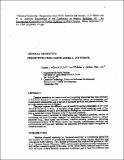Chemical Sensitivity: Perspectives from North America and Europe
Author(s)
Miller, C.S.; Ashford, Nicholas A.
DownloadG42. CS perspectives from NA & EU.pdf (1.420Mb)
Terms of use
Metadata
Show full item recordAbstract
Chemical sensitivity is a controversial and perplexing illness that has been attributed to low-level chemical exposure in industrial workplaces, indoor environments, and contaminated communities, and to the use of consumer products and pharmaceuticals, first in North America and now in Europe. This paper explores the different types of sensitivity and the relationship of low-level chemical sensitivity to them. A synopsis of the largest North American study of the condition conducted to date is provided and its findings are contrasted with observations fro recent nine-county European study of chemical sensitivity. Between-country variations in construction and ventilation practices, choices of furnishings and floor coverings, chemical use (pesticides, fragrances, cleaners), cultural practices (e.g. time spent out-of-doors, window-opening practices), physician awareness/acceptance of the illness, health care systems, compensation practices, and environmental activism may influence the [reported] prevalence and/or recognition of chemical sensitivity.
Date issued
1995-09Citation
Miller, C.S. and N.A. Ashford. (1995). Chemical Sensitivity: Perspectives from North America and Europe. Proceedings of the Conference on Healthy Buildings '95: An International Conference on Healthy Buildings in Mild Climates, Milan, September 11-14, 1995 (in press), 19 pgs.
Keywords
Environmental, Health and Safety, Chemical sensitivity, Chemical exposure, Indoor environment, Healthy buildings, Multiple chemical sensitivity
Collections
The following license files are associated with this item: